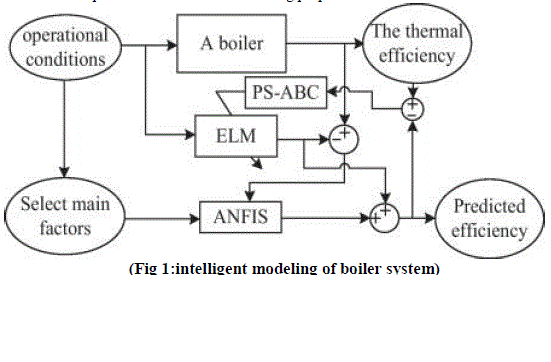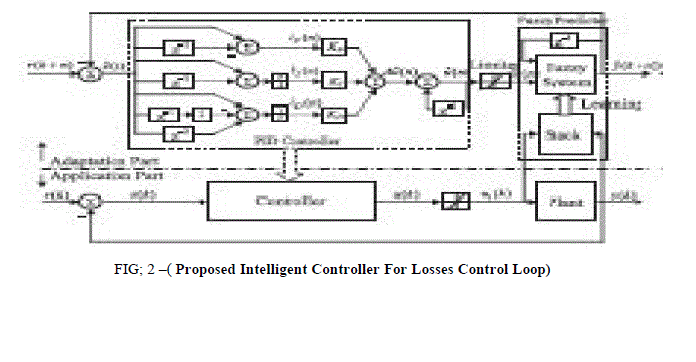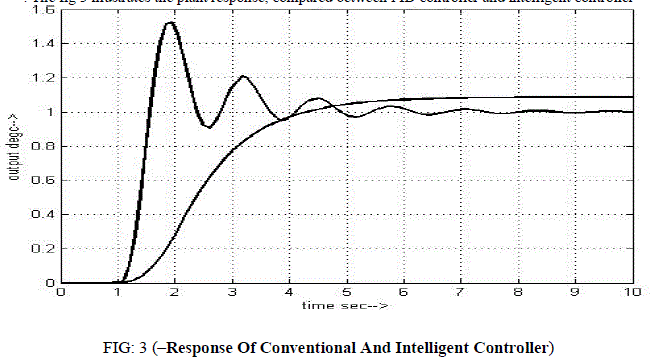Thermal power plant being large and complex, the design of its control system involves numerous problems, such as costs, quality, environmental impact, safety, reliability, accuracy, and robustness. Thus, the use of a multidiscipline approach is suggested to satisfy these requirements in an acceptable and well-balanced manner and a hybridization of soft computing with hard computing proves to be a natural and practical use. Although the soft computing technology has distinguished features, the use of soft computing technology would be ineffective, if it is improperly associated with conventional hard computing technology and control processes. Proper integration is key to success and a general mode of fusion is worth examining. In this paper, through a survey of published literature, a general model of fusion is shown at the system level. In the system level, soft computing is applied to the upper level in a hierarchical control system, performing human-like tasks such as forecasting and scheduling or applied to ill-defined process models for carrying out intelligent control. It is found that intelligent system has suitable & desirable performance as compare to conventional system which helps to improve the overall operational efficiency of total system.
Keywords |
| intelligent system, fuzzy control, neural control, hybrid system boiler efficiency. Losses control |
I. INTRODUCTION |
| Efficiency of any Boiler depends upon minimization of various indirect losses of the boiler. So the amount of energy
input in the boiler by burning the fuel can be maximum utilized for generation of steam and cost of steam can be
minimized ultimately. The following indirect losses can be minimized for efficient boiler efficiency. |
| ��. Dry Flue Gas Loss |
| �� .Fuel Moisture Loss |
| ��. Blow Down Losses |
| �� .Incomplete Combustion Loss |
| �� .Air Moisture Loss |
| ��. Radiation and Convection Loss |
| After knowing the various heat losses it is possible to take counter action |
| Intelligent system offer one of the most potentially profitable usages in recent developments. IS have been used in a
broad range of applications in optimization, prediction and automatic control of process in a power plant by
concentrating on following action over the mention losses control loop. |
| Combustion Control Optimization ----- Combustion controls adjust coal and air flow to optimize steam
production for the steam turbine/generator set. However, combustion control for a coal-fired is complex and impacts a
number of importent operating parameters including combustion efficiency, steam temperature, furnace slogging and
fouling, and NOX formation. The technologies carbon levels in ash, coal flow rates, air flow rates, CO levels, oxygen levels, slag deposits and burner metrics as well as advanced coal nozzles and plasma assisted coal combustion.It can
increase efficiency by0.15% to 0.84%. |
| Cooling System Heat Loss Recover ----- Recover a portion of the heat loss from the warm cooling water exiting the
steam condenser prior to its circulation thorough a cooling tower or discharge to a water body. The identified
technologies include replacing the cooling tower fill (heat transfer surface) and tuning the cooling tower and condenser
It can increase the overall efficiency by,0.2% to 1% efficiency |
| Flue Gas Heat Recover -- Flue gas exit temperature from their preheated can range from 250 to350°F depending on
the acid dew point temperature of the flue gas, which is dependent on the concentration of vapors phase sulphuric acid
and moisture. For power plants equipped with wet FGD systems, the flue gas is further cooled to approximately 125°F
as it is sprayed with the FGD reagent slurry. However, it may be possible to recover some of this lost energy in the flue
gas to preheat boiler feed water via use of a condensing heat exchanger. This contributes increase of efficiency by 0.3%
to 1.5% |
| Low-Rank Coal Drying --- Sub bituminous and lignite coals contain relatively large amounts of moisture (15% to
40%) compared to bituminous coal (less than 10%). Significant amount of the heat released during combustion of low
rank coals is used to evaporate this moisture, rather than generate steam for the turbine. As a result, boiler efficiency is
typically lower fop ants burning low-rank coal. The technologies include using waste heat from the flue gas and/or
cooling water systems to dry low-rank coal prior to combustion.There by Increas e of the efficiency by,0.1% to 1.7% |
| Soot blower Optimization--- Soot blowers intermittently injecting velocity jets of steam or air to clean coal ash
deposits from boiler tube surfaces in order to maintain adequate heat transfer. Proper control of the timing and intensity
of individual soot blowers is important to maintain steam temperature and boiler efficiency. The identified technologies
include intelligent or neural-network soot blowing (i.e., soot blowing in response to real-time Conditions in the boiler)
and detonation soot blow, this in increase the efficiency by ,.0.1% to 0.6 |
| Intelligent systems (IS) provide a standardized methodological approach to solve important and fairly
complex problems and obtain consistent and reliable results over time .The development of digital computers made
possible the invention of human engineered systems that show intelligent behavior or features. |
| AI builds up an intelligent system by studying first the structure of the problem (typically in formal logical terms), then
formal reasoning procedures are applied within that structure. Alternatively, non-symbolic and bottom-up approaches
(in which the structure is discovered and resulted from an unordered source) to intelligent systems are also known.
Fuzzy logic (FL), Neural Networks (NN) and Evolutionary Computation (EC) were integrated under the name
computational intelligence (CI) as a hybrid system |
PAPER ORGANIZATION |
II. INTELLIGENT SYSTEM |
| Soft computing is oriented towards the analysis and design of intelligent systems. It is based on fuzzy logic, artificial
neural networks and probabilistic reasoning including genetic algorithms. Chaos theory and parts of machine learning
has the attributes of approximation and dispositionality Although in hard computing imprecision and uncertainty are
undesirable properties In soft computing ,the tolerance for imprecision and uncertainty is exploited to achieve an
acceptable solution at a low cost, tractability, high Machine Intelligence. Soft computing, is a consortium of
methodologies providing a foundation for the conception and design of intelligent systems,aimed at a formalization of
the remarkable human ability to make rational decision in an uncertain and imprecise environment. The guiding
principle of soft computing is: Exploit the tolerance for imprecision, uncertainty and partial truth to achieve tractability,
robustness, low solution cost and better rapport with reality. |
| Fuzzy logic (FL) is mainly concerned with imprecision and approximate reasoning, Neural Networks (NN) mainly with
learning and curve fitting, Evolutionary Computation (EC) with searching and optimization. The constituents of soft computing are complementary rather than competitive. The experiences gained over the past decade have indicated that
it can be more effective to use them in combined manner rather than exclusively. |
1 Fuzzy Logic |
| Fuzziness refers to no statistical imprecision and vagueness in information and data. Most concepts dealt with or
described in our world are fuzzy. In classical logic known as crisp logic, an element either is or is not a member of a
set. That is, each element has a membership degree of either 1 or 0 in the set. In a fuzzy set, fuzzy membership values
reflect the membership grades of the elements in the set. Membership function is the basic idea in fuzzy set theory
based on fuzzy logic, which is the logic of “approximate reasoning.” It is a generalization of conventional (two-valued
or crisp) logic. Fuzzy sets model the properties of imprecision, approximation or vagueness. Fuzzy logic solves
problems where crisp logic would fail. Fuzzy logic is being applied in a wide range of applications in engineering areas
ranging from robotics and control to architecture and environmental engineering. |
2 Neural Networks |
| An artificial neural network (briefly: neural network) is an analysis paradigm that is roughly modeled after the
massively parallel structure of the brain. It simulates a highly interconnected, parallel computational structure with
many relatively simple individual processing elements. It is known for its ability to deal with noisy and variable
Information. |
3. Evolutionary Computing |
| Evolutionary computing comprises machine learning optimization and classification paradigms roughly based on
mechanisms of evolution such as biological genetics and natural selection. The evolutionary computation field includes
genetic algorithms, evolutionary programming, genetic programming, evolution strategies, and particle swarm
optimization. It is known for its generality and robustness. Genetic algorithms are search algorithms that incorporate
natural evolution mechanisms, including crossover, mutation, and survival of the fittest. They are usedfor optimization
and for classification. Evolutionary programming algorithms are similar to genetic algorithms, but do not incorporate
crossover. Rather, they rely on survival of the fittest and mutation. Evolution strategies are similar to genetic algorithms
but use recombination to exchange information between population members instead of crossover, and often use a
different type of mutation as well. Genetic programming is a methodology used to evolve computer programs. The
structures being manipulated are usually hierarchical tree structures. |
| Particle swarm optimization flies potential solutions, called particles, through the problem space. The particles are
accelerated toward selected points in the problem space where previous fitness values have been high. Evolutionary
algorithms have been applied in optimization to multiple-fault diagnosis, track determination, schedule optimization,
conformal analysis, load distribution, neural network explanation facilities, and product ingredient mix optimization.
Classification applications include rule-based machine learning systems and classifier systems for high-level semantic
networks. |
4. Hybrid Systems |
| Hybrid systems combine two or more individual technologies (fuzzy logic neural networks and genetic algorithms)for
building intelligent systems. The individual technologies represent the various aspects of human intelligence that are
necessary for enhancing performance. However, all individual technologies have their constraints and limitations.
Having the possibility to put two or more of them together in a hybrid system increases the system’s capabilities and
performance, and also leads to a better understanding of human cognition. Into the following four categories:
Combination: typical hybrid architecture of this kind is a sequential combination of neural networks and ruler fuzzy
rule-based systems. |
| Integration: this architecture usually uses three or more individual technologies and introduces some hierarchy among
the individual subsystems. For example, one subsystem may be dominant and may distribute tasks to other subsystems.
Fusion: a tight-coupling and merging architecture usually based on the strong mathematical optimization capability of
genetic algorithms and neural networks. When other techniques incorporate these features, the learning efficiency of
the resulting system is increased. |
| Association: the architecture that includes different individual technologies, interchanging knowledge and facts on a
pair wise basis. with.”Fuzzy logic is mainly concerned with imprecision and approximate reasoning, neural networks
mainly with learning and curve fitting, evolutionary computation with searching and optimization. |
III. INTELLIGENT MODELING OF BOILER |
| In this paper we are using a model which is composed of ELM ,ANFIS and PS ABC .to . build a global model. Hear
and ANFIS is applied to identify and compensate the training error of the main model., ELM in order to improve the
precision of hole model andPS--ABC is use to optimize input weight and hidden layer . In order to set this model
validity, it is applied to set up the mapping relation between the boiler efficiency and operational condition of a
300MW coal fired boiler. This method can be applied to minimizes thermal losses through proper regulating of
associate control loop. ELM EXTREM LEARNING MACHINE belong to the artificial neural network ANN
FAMILY. It is a single layer hidden feed forward neural network. One key principle of the ELM is that the hidden
nodes parameters are randomly chosen and fixed ANFIS is class of adaptive multilayer feed forward networks, The
ANFincorporate the self learning ability of neural network with the linguistic expression function of fuzzy inference.
Namely ANFISallowes the if = then rules and the membership function to be constructed based on historical data and
synchronously it includes the adaptive nature for automatic tuning purpose |
| The ABC algorithm has already proved to be a very effective optimization technique for solving global optimization
problems. ABC not only is a high performance optimizer which is very easy to understand and implement. The PSABC
algorithm is a modified high efficiency hybrid ABC algorithm. It has extremely fast convergence speed and owns
better search ability. |
IV. INTELLIGENT CONTROLLER |
| The adaptation part includes the PID controller and the fuzzy predictor The PID controller computes the control
actions. The predictors constructed only from the measurement of the input–output data of the actual process as a fuzzy
model, without requiring a first principal model of the process which is usually very difficult to obtain. the multi step
ahead predictions of the process output are provided by fuzzy predictor. The fuzzy predictor output is used to adjust the
gains by minimizing the sum of the squared errors between the predictions and the referenced over the prediction
horizon.Thefuzzypredictoristrainedonlinetoadapttothevariationsinplantparameters, and thus improve the prediction
accuracy |
| A certain history of the actual plant inputs and outputs is stored in first-in first-out stack, providing the online training
data at each training step The PID controller gains and the predictor fuzzy system parameters are both adjust. The
actual plant is controlled by a PID controller identical to that oadaptation phase, the gains of which are transfer at each
control cycle |
V. RESPONSES OF CONTROLLERS |
| We can see that intelligent system (adaptive fuzzy neural net work) is significantly better than any control method. This
control system has shorter adjusting time. When load changes it has better adaptability |
| . As can be observed, better performances are showing using the intelligent controller to Conventional PI controller.
Intelligent system has faster anticipation in any change in the process variable. |
VI. CONCLUSION |
| As discuss in this paper a clearly designed optimal regulator realizes considerable improvement of control performance
in thermal power plants. Prior to implementation, it is advisable to perform simulation studies on a plant model. The
programs for system analysis and controller design should be prepared in the plant computer so that plant engineers are
able to understand the basic concepts, analyze the plant dynamics, adjust the feedback gain, and also are able to transfer
the techniques to the next generation. |
| |
Figures at a glance |
 |
 |
 |
| Figure 1 |
Figure 2 |
Figure 3 |
|
| |
References |
- S.Panda, Dr.N.K.Barpanda, P.Ratha ,S.Pradhan, A New Approach for Optimal Operation of Thermal Power Plan,. IJIRSE,. Volume 3,Special Issue 3, ISSN- 2319-8753,MARCH 14
- S. Panda, Ajitpatro, DR( MRS) S. Babu, Adaptive NeuroFuzzu Controller For Thermal Power Plant Optimazation, , I J E TTCS, ISSN-2278,Vol 2 ISSUE 6, 2013.
- S. Panda, B. Swain, Dr( MRS) S. Babu, Dr C .S.Panda, Artificial Intelligent In Thermal Power Plant For Losses Control. I J AR.vol. -01, Issue6, ISSN, 584-588, 2013
- S. Panda, B. Swain, S. Mishra, Boiler Performance Optimization Using Process Neural Network,.I J A R, ISSN-2249-555, vol -03 , issue -7,2013.
- S. Panda, B. Swain, S. Mishra, Blowdown Losses Control In Thermal Power Plant Using Neural Network, IJOART,.Vol -2, issue -5, ISSN -2278-7763, 2013
- S. Panda, B. Swain, Enhancing Thermal Power Plant Efficiency Using Soft Computing, .IJERT, Issue -03. Vol -2, ISSN: 2278-0181 ,2013
- S.PANDA, Thermal Power Plant Efficiency Optimization Using Back Propagation Neural Network ATCIT -2013 during 11THTO 13th at dept.of computer science, Sambalpur university.
- S.PANDA. Dr.(Mrs) S. Baboo.Thermal Power Plant Automation Using Adaptive Neuro Fuzzy Controller, ICCCI 2013 Internationalconference on at GIET, Gunupur.oct. 27th to 29th 2013
- S.PANDA,Dr N.K Barpanda A new Approach For Optimal Operation Of Thermal Power Plant , IEEE CONFERENCE (ICIET 2014) At KLNCollege, Maduri,march 22nd to 24th 2014
- S. PANDA , Dr.N.K.Barpanda, Application Prospect Of Intelligent System For Losses Control In Thermal Power Plant AT IEEE Conference(IC ETST 2014) during 22ND to 23RD Aug 2014 At SSSUTMS,Bhopal
|